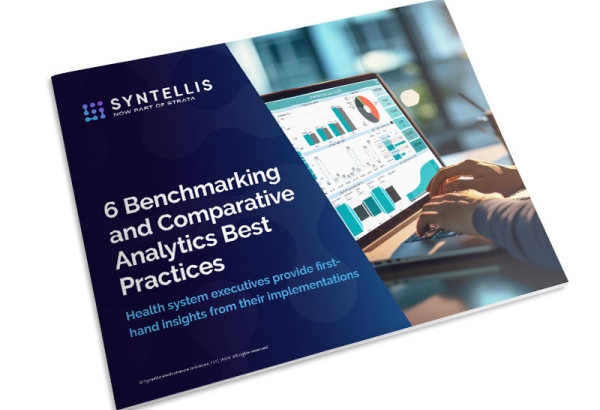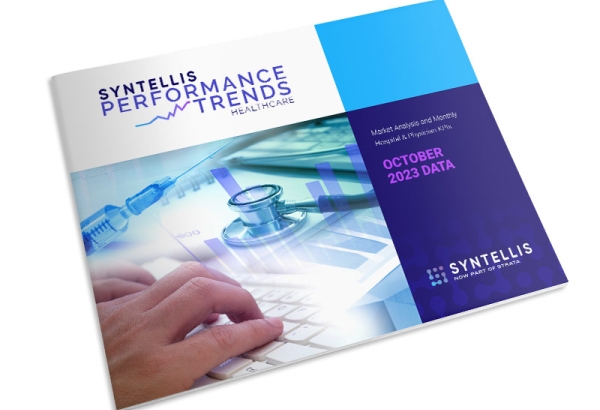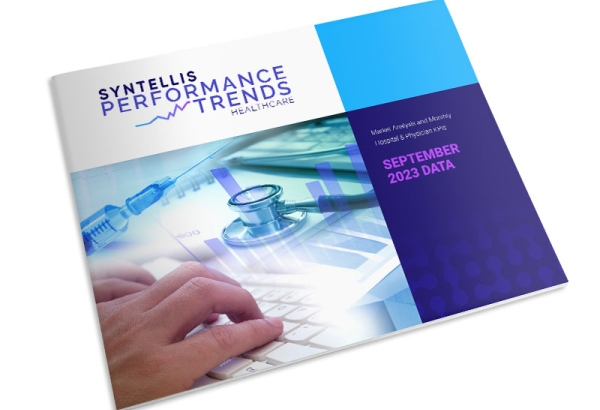With a pressing need to control costs and improve performance, leading hospitals and health systems turn to technology for timely access to data to compare key financial, operational, and clinical metrics across their organization and with relevant peers. While most healthcare organizations — 78% — use benchmarks to monitor performance and guide improvements, just as many finance leaders acknowledge they should be doing more to optimize data for informed decision-making.
Comparative analysis can be used to compare an organization to external peers, internal peer departments, or historical performance. Using a wide array of financial metrics like data on the net revenue, productivity, and compensation of physicians, nurse practitioners, and physician assistants, leaders can compare their healthcare system’s own financial performance against peers to pinpoint problem areas and develop corrective strategies.
The right comparative data can help healthcare finance leaders identify cost saving opportunities to boost their bottom line as well as pinpoint opportunities for growth. Integrating this data into the budget process is an essential step to controlling costs and improving performance.
Consider how comparative data can be used to bolster, streamline, and improve a healthcare organization’s budgeting process in the following ways.
1. Establish financial targets
Financial targets should be established not only at the C-suite level, but down to each department as well. The CFO and other finance leaders should target specific contribution margins and net margins, but department managers should set targets and expectations for labor expense, non-labor expense, revenue, and other critical performance metrics. Establishing these financial targets at all levels of the organization can help hold managers responsible for the organization’s financial success.
2. Identify key labor and non-labor variances
Once financial targets are set, leaders should keep a close eye on budget variances to identify opportunities for improvement before it’s too late to course correct. From a labor perspective, identifying budget variances allows leadership to look at the construction of a department, to question certain things, and to work with managers to get a better understanding of how to improve productivity and control labor costs. For non-labor expenses, budget variances can help pinpoint opportunities to better control hip replacement supply costs, as an example.
Identifying areas for performance improvement can help leaders understand where to implement new initiatives.
3. Establish department labor and non-labor targets
Once areas for improvement are identified, managers should then establish performance targets based on internal and external benchmarks. What are peers spending on labor and non-labor expenses? How can they cut costs based on those targets? For example, if a department is currently in the 60th percentile for labor costs, but the target is the 65th percentile, managers should have conversations about why those variances exist and what types of initiatives could help the department get on track.
4. Develop and implement cost reduction initiatives
Once leaders know how their costs compare to their peers and use the data to pinpoint opportunities, they can then course correct with cost reduction initiatives. For example, by using data on net revenue, productivity, and compensation of physicians, nurse practitioners, and physician assistants, leaders can analyze the profitability of their physicians' practices and how they compare to competitors in the region. The cost reduction initiatives should be aimed at reducing labor and non-labor expenses based on that.
5. Engage in growth initiatives
Growth is twofold. Healthcare leaders need to know where to grow — which service line should we expand, where should we open a new facility, etc. — and how to manage costs to grow profitably. Market data provides visibility into where those opportunities exist and the necessary context into how an organization compares to others in the market in areas such as physician leakage, in and out migration volume, payer reimbursement, and more.
6. Model new initiatives
New initiatives mean change is on the horizon. Using comparative data to model new initiatives can help leaders manage through the change. Whether it’s cost reduction strategies or new services, comparative data allows you to model what’s a good fit financially and how it will affect overall operations.
7. Validate the budget
Leaders should be sure to compare themselves against peers on multiple organization wide levels, not just department to department. Looking at functional levels can surface unique insights.
The department budget validation provides a more granular view of opportunities for continuous improvement, looking at the construction of that department to answer questions and get a better idea of the art of possible. Functional area budget validation, on the other hand, looks at different aggregation levels, rather than every individual department.
When leaders look at a department alone, they might see a variance. By looking at it instead from a functional level, they gain a more holistic view into how specific services — such as imaging, nursing, or therapy — contribute to the budget. This allows them to compare budgeted targets with actual performance, as well as to peers at a functional group level.
As leaders start to look at their budget process, consider the following questions:
- How does the health system compare against peers?
- How does it compare against targets?
- Is the system moving in the right direction?
- Is the team and organization continuously improving?
Moreover, validating at the system or facility level provides checks and balances to make sure that all of those related data are cross-fitting properly, and that you don't see any anomalies that need further investigation. Completing system and facility budget validation helps leaders evaluate how the company looks overall.
8. Monitor organizational performance and initiatives
Even once the budget is approved, comparative analytics still play a key role in monitoring performance against the budget. At this point, the organization should have established, actionable targets, buy-in from management, views of the data and the results at multiple levels of the organization (from system, to entity, to functional group, to department), visibility into where variances occur, and, ideally, ideas for how to improve performance to address those variances. Performance improvement is a continuous process that starts with the budgeting process.
By making comparative analytics a cornerstone of the healthcare budgeting process, leaders can report on KPIs and performance compared to peers, rather than an income statement, as an example. This type of reporting empowers managers to operate with a different, broader focus – not so much as what invoices were paid, but how every level of the organization contributes to the bottom line.
Putting comparative analytics to work
Ultimately, comparative analytics and budget planning can be used together to help leaders answer: how do I grow my business, and how do I manage my costs? For leaders looking to do both, they need robust software that not only gives them access to peer data, but also insights into the market to be able to forge ahead.
With data from more than 1,300 hospitals and 135,000+ physicians, Axiom™ Comparative Analytics offers monthly benchmark data with automated updates to help leaders quickly identify cost saving opportunities, compare performance to peers, and develop corrective strategies.
Contact us today to find out how our Comparative Analytics solutions can improve your budgeting process.

6 Benchmarking and Comparative Analytics Best Practices

Market Analysis and Monthly Hospital & Physician KPIs: October 2023


